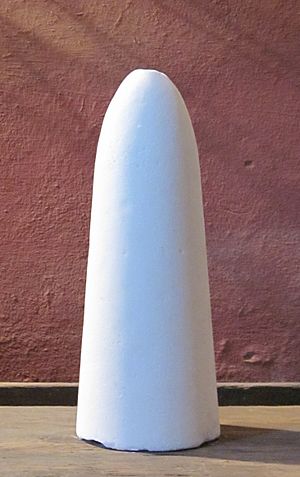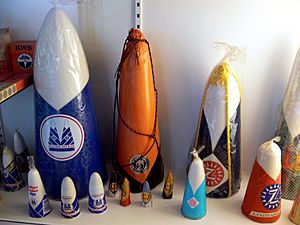Sugarloaf facts for kids
A sugarloaf was the common way refined sugar was made and sold a long time ago. Before we had granulated (loose grains) or cube sugars, people bought sugar in these tall, cone-shaped blocks.
These sugarloaves were the final product of a process that turned dark, raw sugar (like molasses) into white sugar. This raw sugar often came from places like the Caribbean and Brazil.
Contents
The History of Sugarloaves
The idea of sugar in a cone shape is very old! One of the earliest mentions is from the 9th century in an Arabic book. Records show sugarloaves were made in Jordan by the 12th century.
In Europe, countries started making them later:
- Italy: 1470
- Belgium: 1508
- England: 1544
- The Netherlands: 1566
- Germany: 1573
- France: 1613
Even when sugar started being made from sugar beets in Europe around 1799, it was still shaped into loaves.
For a long time, countries like Britain made it hard for their colonies to refine sugar. Instead, raw, dark sugar (called muscovado) was sent to Europe. This raw sugar was made on large farms called plantations. It was then refined into white sugarloaves in Europe.
Sugarloaves were so common that they became a symbol for grocers. You might see a sugarloaf sign outside a grocer's shop or in their window.
How Sugarloaves Were Made
Making a sugarloaf was a careful process. First, the raw sugar was cleaned through many boiling and filtering steps.
Once the sugar was ready, it was poured into many upside-down cone-shaped molds. These molds were usually made of clay or metal. Each mold sat in its own collecting pot.
Over a few days, most of the dark, sticky syrup would drain out through a small hole at the bottom of the mold. To make the sugar even whiter, workers would pour a special liquid (like white clay mixed with water) over the top of the loaf. This liquid slowly dripped through the sugar, taking away any leftover dark syrup or colors.
After drying, the sugarloaves were carefully removed from their molds. They were then trimmed to their final shape and wrapped. Often, they were wrapped in blue paper, which made the white sugar look even brighter!
Before people could use a sugarloaf, they had to break off pieces. They used special tools for this, like sugar axes, hammers, or Sugar nips.
Different Sizes and Grades
Sugarloaves came in many different sizes. Generally, the larger the loaf, the lower the quality of the sugar. The quality of the sugar decided its price.
When a new batch of raw sugar was refined, the very best sugar came from the first boiling. Any leftover sugar or trimmings from this first boiling would be put back into the process with more raw sugar for a second boiling. Each time this was repeated, the quality of the sugar would get a little lower.
The smallest and best sugarloaves were very expensive. They might be only about 5 inches (13 cm) tall and wide. These took a lot of extra work to make them super white.
Lower quality sugars were harder to make into small, perfect crystals. So, larger molds were used for these. These loaves could be about 10–14 inches (25–36 cm) wide and up to 30 inches (76 cm) tall, weighing as much as 35 pounds (16 kg). The lowest refined sugars were sometimes called "bastards."
In the past, families bought large sugarloaves. They would break off pieces using strong tools like sugar-cutters. These loaves were big, sometimes 14 inches (36 cm) wide and 3 feet (0.91 m) tall in the 15th century! People used sugar carefully back then, so one loaf could last a long time.
Sugarloaves Today
Today, most people use granulated or cube sugar. But sugarloaves are still made as special items. They are quite popular in Germany. Small sugarloaves are a key ingredient for a traditional Christmas drink called Feuerzangenbowle.
See also
 In Spanish: Pan de azúcar (alimento) para niños
In Spanish: Pan de azúcar (alimento) para niños









